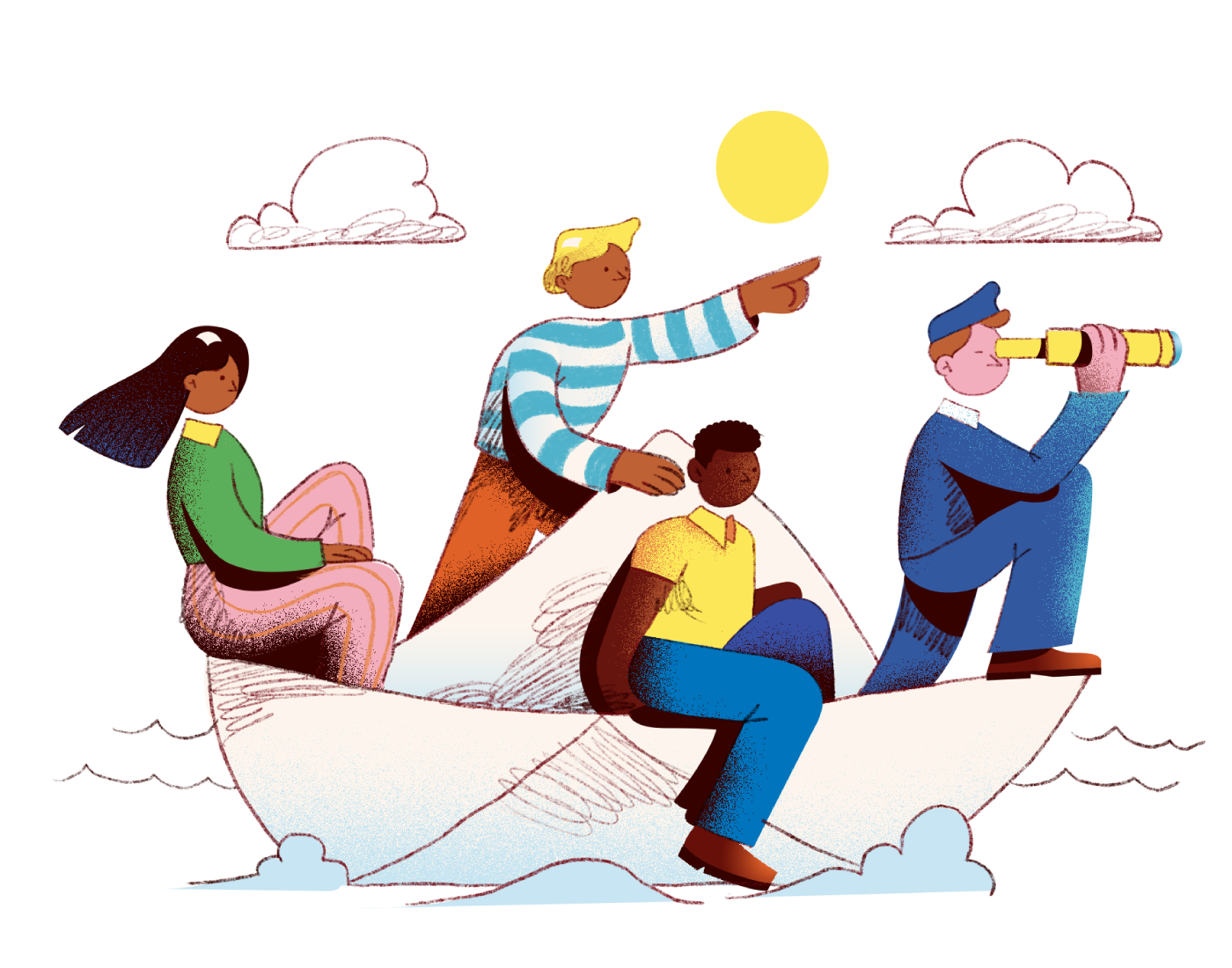Workplaces have never been as age diverse as they are today. For the first time, managers are tasked with leading up to five generations (Silent Generation, Baby Boomers, Gen X, Millennials, and Gen Z) at once, and it’s proving to be a collective challenge. Only 6% of organizations strongly agree that their leaders know how to effectively manage intergenerational teams, according to a recent survey by Deloitte.
This has consequences, as poorly managed generational differences can result in age bias, negative impact on job attitudes, dysfunctional team dynamics, and lower levels of overall job performance.
Conversely, well-managed generational diversity has the potential to bring substantial benefits, ranging from knowledge transfer and mentoring to innovation and reduced turnover. Beyond that, it creates opportunities to develop something even more valuable: intergenerational friendships at work.
The Benefits of Intergenerational Friends
While few studies focus specifically on intergenerational friendships at work, research has consistently shown that workplace friendships contribute to our personal well-being and professional performance. Gallup’s research on employee engagement, for example, finds that having a best friend at work is a key element in productivity, innovation, and idea sharing. Given these findings, it’s safe to assume that intergenerational friendships have the potential to dampen age-related difficulties between colleagues and increase the chances of productive collaboration across age groups.
At the same time, these kinds of connections are unlikely to develop naturally. Our tendency to gravitate towards individuals whom we perceive as similar to ourselves — especially in age and generation — is a well-documented phenomenon known as the similarity effect or homophily. As a trio of researchers from the University of Arizona and Duke University found, homophily “limit’s people’s social worlds in a way that has powerful implications for the information they receive, the attitudes they form, and the interactions they experience.” This inclination is often reinforced when employees enter the workforce alongside their peers, fostering a desire to collaborate with those from the same generation.
Research indicates that younger individuals particularly prefer working with people in their age range. Older individuals also have reasons for not actively seeking age-diverse friendships at work. As seasoned workers climb the organizational hierarchy, their responsibilities and demands increase, limiting their time and interest in connecting with younger colleagues. These trends contribute to a natural age polarization within organizations.
Once established, however, intergenerational friendships can provide a less judgmental or competitive relationship than employees may experience with coworkers of a similar age. Research shows that when we consider someone a peer, we are more threatened by their chances for upward mobility, especially when compared to our own, than with people who are in different life stages and at differing levels of their careers.
This is just one example of the potential power of intergenerational friendships in the workplace. While click-bait headlines and social media memes may lead us to believe that generations are in constant competition, our research for our book Gentelligence shows otherwise. We found that authentic intergenerational interactions can bring out complementary types of expertise, and result in experiences that benefit people across ages and career stages.
How to Foster These Friendships on Your Team
Managers, specifically, have a unique the opportunity to encourage intergenerational connection on their teams. Here are five ways to do that based on our research findings.
Dismantle stereotypes.
Initiating discussions that dismantle generational stereotypes and mitigate age-based biases is a crucial first step to identifying and reversing generational misperceptions. As a manager, you could conduct an “assumption audit.” Have your team spend a week looking for where they notice broad-based, age-related stereotypes in action (from themselves or others) and encourage them to respectfully bring awareness to these stereotypes when they occur.
For example, asking the question, “Is that necessarily true?” when you hear someone remark that “Gen Z doesn’t ever want to return to the office,” can be an effective way to push back on unfounded beliefs. Callout questions can be powerful — whether you’re asking them during your one-on-one meeting or in a team meetings where age-based generalizations may show up in discussions. If you’re willing to pause the conversation to respectfully raise awareness and challenge harmful stereotypes, you’ll establish what behavior is and isn’t appropriate on your team, and help foster a culture of respect across age groups.
Help suspend judgment.
Coworkers of different generations may have learned different norms and ways of thinking about issues like communication, technology, work priorities, and success. A lack of understanding around the roots of these differences can prevent friendships from developing between those who might otherwise find natural connections.
Consider the example of Amy Cochran, a partner with PwC. She created friendships with many younger employees at her organization. Rather than judging the different ways people communicate or prioritize their work, Cochran took the time to understand age-related disconnections that may have otherwise caused tensions in her relationships.
Managers should encourage their team members to show the same level of curiosity about one another. Coach people not to assume something is wrong just because it is different. For example, when an older colleague is adamant that young employees need to be physically present in the office to be productive, rather than dismissing their concern as an outdated way of thinking, re-enter the conversation without judgment. You could say: “Help me understand why you feel physical attendance is so important. I haven’t found that to be helpful to my own productivity so far, and would like to understand what I may be missing.” The phrase “help me understand” can be a powerful way to reframe a potential clash and help your employee look for common ground.
Spotlight the reciprocal benefits.
Michael Clinton, former president of Hearst Publishing (and now Hearst’s media advisor to the CEO), carves out time every quarter with his younger employees, whom he believes bring immense talent to the business. These regular meeting opportunities have helped Clinton develop professional friendships across age groups. His younger colleagues keep him up to date on the fast-changing data universe while he helps them navigate their career growth.
As a manager, you can encourage the same kinds of collaborations by calling attention to the unique contributions your intergenerational team members offer. During team meetings, proactively set the stage by asking older and younger colleagues to share areas where they are hoping to upskill and develop, as well as asking who (regardless of age) would be interested in stepping up to provide that learning. Research shows that younger generations, in particular, are motivated by development opportunities focused on gaining knowledge. In the same way, older generations are motivated by what is known as “generativity”, or the desire to strengthen the next generation of employees by passing on experiences and insights they have gained during their career.
Mix it up.
Whether your employees work in the office or remotely, assess the potential for friendly and informal interaction. As many workplaces look to reconfigure their offices to accommodate flexible work and return-to-the-office strategies, managers should use the opportunity to move away from antiquated set-ups where employees of different seniority levels reside in different places. Instead, create comfortable, communal work and community spaces that encourage those who may not have previously had the chance to cross paths to connect over a coffee break or strike up a conversation about their current work (and life) challenges.
Erin Mantz, vice president of engagement at Zeno Group (and a Gen Xer), recalls a past friendship with a Baby Boomer colleague borne from their adjoining cubicles. She would come in many mornings during the challenging early years of raising her kids, and her older colleague was a great sounding board on ways to try to balance work and motherhood. Mantz notes that the same kind of connections can happen virtually if the organization has fostered a friendly culture and time for personal exchanges, even if it’s just on a daily Teams chat.
Because coworkers of various generations are often in different phases of their lives, intergenerational friendships offer perspectives that may not occur in relationships within one’s age cohort. Providing both physical and virtual spaces to appreciate those benefits is a great way to build a generationally inclusive culture.
Emphasize shared purpose.
Remind employees that they contribute to something greater than any specific age or generational group: the company’s shared mission. Individually, employees of different generations might appear to have disjointed perspectives, but managers should challenge them to come together and combine their experiences and ideas to help the organization tackle tough challenges in new ways.
Try issuing an intergenerational problem-solving mission that motivates people to come together in new and expected ways. For example, form intergenerational task forces to tackle questions like “How can we integrate new AI strategies into our business while staying true to the values we were founded upon?”
Taryn Neubecker, senior director of project development & execution at Sevita, has found that coming together to solve a business challenge has allowed her to develop friendships with colleagues across different age groups. Everyone, regardless of age, is there to help advance the common mission, providing a great springboard to then spark intergenerational friendships. Through those opportunities, common interests beyond project success often emerge.
Researchers Laura Dietz and Ulrike Fasbender said it best: “Age-diverse friendships could unite age-diverse workplaces.” Managers must help their employees see generational diversity as an opportunity rather than a frustration. Intergenerational workplace friendships may be the linchpin to help us all make that vital shift in perspective.


